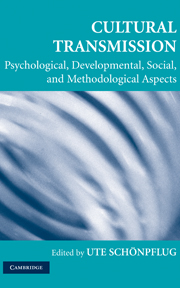Book contents
- Frontmatter
- Contents
- Foreword
- Contributors
- 1 Introduction to Cultural Transmission: Psychological, Developmental, Social, and Methodological Aspects
- 2 Theory and Research in Cultural Transmission: A Short History
- PART ONE EVOLUTIONARY PERSPECTIVE
- 3 Cultural Transmission: A View from Chimpanzees and Human Infants
- 4 Transmission, Self-Organization, and the Emergence of Language: A Dynamic Systems Point of View
- 5 Relationship-Specific Intergenerational Family Ties: An Evolutionary Approach to the Structure of Cultural Transmission
- PART TWO CROSS-CULTURAL PERSPECTIVE
- PART THREE INTRACULTURAL VARIATIONS
- Index
- References
5 - Relationship-Specific Intergenerational Family Ties: An Evolutionary Approach to the Structure of Cultural Transmission
Published online by Cambridge University Press: 05 June 2012
- Frontmatter
- Contents
- Foreword
- Contributors
- 1 Introduction to Cultural Transmission: Psychological, Developmental, Social, and Methodological Aspects
- 2 Theory and Research in Cultural Transmission: A Short History
- PART ONE EVOLUTIONARY PERSPECTIVE
- 3 Cultural Transmission: A View from Chimpanzees and Human Infants
- 4 Transmission, Self-Organization, and the Emergence of Language: A Dynamic Systems Point of View
- 5 Relationship-Specific Intergenerational Family Ties: An Evolutionary Approach to the Structure of Cultural Transmission
- PART TWO CROSS-CULTURAL PERSPECTIVE
- PART THREE INTRACULTURAL VARIATIONS
- Index
- References
Summary
INTRODUCTION
Cultural transmission encompasses those processes that transmit and modify beliefs, attitudes, and values in a population. To understand these processes, it might not be satisfactory merely to know how the existing structures of cultural transmission give rise to cultural change. Rather, we also need to understand why cultural transmission has the structures that it shows (Boyd & Richerson, 1985; Richerson & Boyd, 2003). Evolutionary theories of human behavior are indispensable for finding satisfactory answers to this “why” question. Such theories address the question of why the human mind (or that of other animals) holds the particular design features that it does, as opposed to other, nonexistent yet conceivable ones (Pinker, 1997; Tooby & Cosmides, 1992). Because culture is a product of the mind, mind features can explain cultural phenomena to some extent (Dawkins, 1982; Miller, 2000), including cultural transmission. Evolutionary theories may facilitate understanding by guiding us to see the relevant aspects of natural phenomena or, as Socrates suggested and Plato wrote, to “carve nature at its joints” (Gangestad & Snyder, 1985, p. 317). Such guidance may help to steer us away from suboptimal concepts like those inspired by changing zeitgeist or individual predilections. With it, we avoid becoming entangled in an overabundance of unconnected middle-level theories, a state that characterizes several disciplines of human behavior and impedes scientific progress.
- Type
- Chapter
- Information
- Cultural TransmissionPsychological, Developmental, Social, and Methodological Aspects, pp. 70 - 92Publisher: Cambridge University PressPrint publication year: 2008



